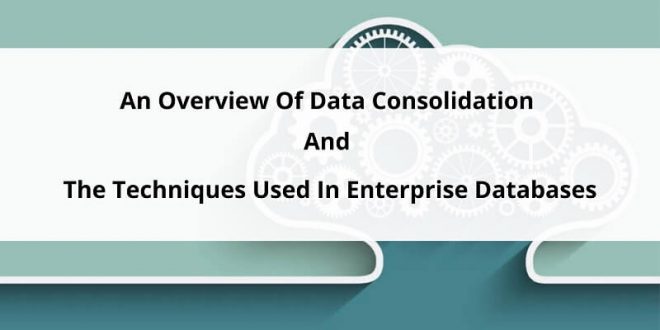Hey friends, In this article, we will discuss an overview of data consolidation and the techniques used in an enterprise database. It will help you organize your data efficiently. So keep reading.
If you are running a successful business, then the external world may think you have a much-systematized structure. However, internally, it may always be an assortment of different data types coming from various databases and many other sources.
Such data will help a business to evolve and improve by managing the data efficiently continuously. Data consolidation is one such approach in enterprise database management, which will help you achieve this.
Knowing An Overview Of Data Consolidation
In all enterprises, data is generated from various sources and in a wide range of formats. Consolidation is the approach to amalgamating all these diverse sets of data to eliminate any redundancies and help eradicate any inaccuracies before the data is stored in any location like a database or data warehouse.
Consolidation of data will help organizations better plan and manage their business processes and be prepared for any disaster recovery needs.
This can be achieved, so critical enterprise data is one place where you will get a comprehensive view of all business assets.
Having this will eliminate any scope of errors, help in the quick execution of the processes, and simplify access to information.
Techniques For Data Consolidation
Data consolidation can be done through various techniques as below.
ETL Method
ETL stands for Extract, Transform, and Load data, one of the widely used techniques for data consolidation. It is an approach where data is extracted from the source and loaded to the target destination after transformation is done in terms of cleansing, sorting and aggregating data.
There are two distinct ways to carry out ETL as:
- Batch processing: This ETL I operation mode is ideal while dealing with high-volume, repetitive types of data jobs.
- Real-time ETP: TL: This is used in CDC or Change Data Capture to transfer data from the source to target in real-time.
To adopt a proper data consolidation method for your enterprise database, you can take expert consultation by providers like RemoteDBA.
Data Virtualization
This is the process of integrating data from different data sources without moving or replicating it. Virtualization offers the data operators a more virtual and consolidated view of enterprise information.
Unlike the ETL process, in virtualization, data is not moving. It can still be retrieved virtually by various front-end solutions like dashboards, applications, and web interfaces without revealing the storage destination.
Data Warehousing
It is a comprehensive approach to data integration. Data from various locations and multiple sources are stored in a central repository called a data warehouse, facilitating better reporting, business intelligence, and querying.
It can also provide a broader and integrated view of various data and cluster together with the most relevant data.
With all relevant data gathered in a single place, it becomes much easier and quicker to determine the trends and devise business strategies accordingly.
The need for data consolidation depends on two different aspects as the number of sources of data and a single view of the master entity.
From the perspective of data input, with a greater number of sources to be mapped into the master database, there comes a greater complexity in resolving different versions into surviving the data instances.
From a data access perspective, you have first to consider if there is a need for immediate access to the master records like an analytical application to devise this.
Immediate access to every given record may need a better approach to doing the consolidation, which must be done before registering the master environment.
However, this alternative will also allow consolidation to be applied to every record based on the requests.
Batch Versus Inline Consolidation
The Batch and inline are two operational methods for consolidation. Batch consolidation drama with a collection of several data sets’ static views and importing them into one location. This location can ideally be a target database or a staging area etc.
Further, the combined set of data instances can be consolidated through parsing, blocking, standardization, matching, etc. Inline approach, on the other hand, members all consolidation tasks within an operational service made available at any time as new information is fed into the system.
Inline data consolidation will help compare each new instance of data with the master registry and determine any equivalent instance within the environment.
In this model, the latest acquired data instances will be standardized and pass to prepare for comparison against different versions managed within a master registry.
Different approaches taken for consolidation will be decided based on the application requirements and architecture to ensure consistency.
The batch consolidation approach is an application related to the migration process for data accumulation from various systems, which all can be consolidated into a master environment. Batch processing will allow you to standardize the collected records and resolve any duplicates.
Integration
The integration layer consists of the mechanics of all the data consolidation. Managing metadata can be consulted within the context of various data elements and data entities, which would qualify for the inclusion of master repositories.
Data Quality
Data quality is ensured with a set of services to ensure several parameters, including the data values, standardizing data, and preparing it for matching and integration, and identity resolution.
It is also important to data profiling for monitoring and analysis of data.
Overall, the data consolidation tasks can offer several unique benefits to a business. When data is getting stored at a location, it requires a setup for managing it well.
This will let the businesses cut down the costs. Also, through consolidation, you can better control the data as there are only fewer processes involved for the retrieval and analysis of data.
Along with gaining access to data from anywhere at any time, consolidation can also offer significant time savings, better planning, implementation, and enabling disaster recovery, making it easier to handle the critical data in a location.
So that’s all from our side I hope you liked this article on an overview of data consolidation and the techniques used in an enterprise database. Furthermore, if you like this article then please share it with your friends and social media followers.
 free html design Free html design templates
free html design Free html design templates






